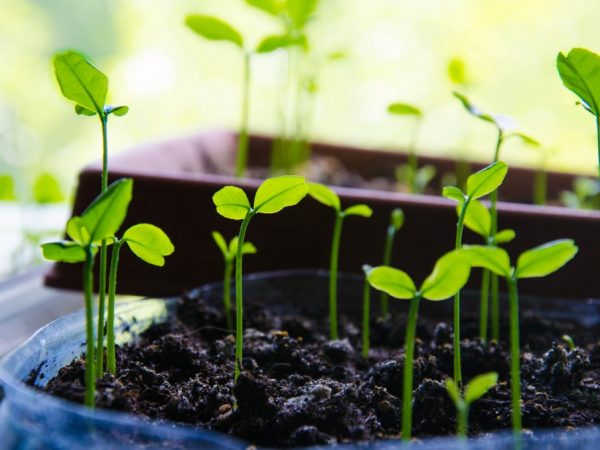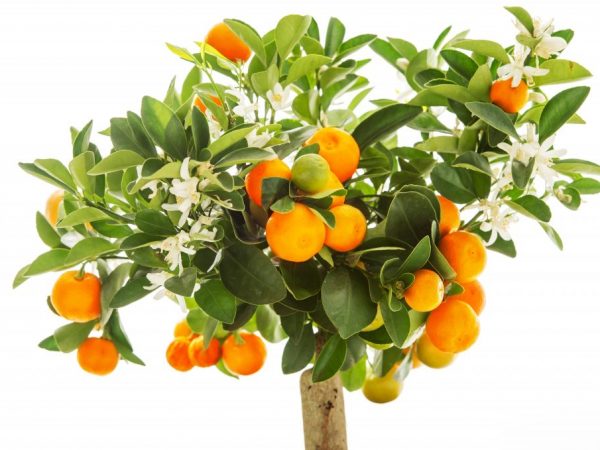Growing a tangerine from a bone at home
Growing exotic fruits on a windowsill in an apartment has already become a common practice. Lemons, oranges, tangerines are grown at home. Growing a tangerine from a bone at home is not such a difficult task. But the care of the tangerine tree requires careful.

Growing a tangerine from a bone at home
Plant characteristic
The bone tree does not bear fruit or produces small and tasteless fruits. It is kept at home as a decorative element of the interior. In addition, the leaves have a pleasant citrus scent. Fruit-bearing plants reproduce vegetatively: with the help of cuttings.
This citrus is suitable for growing on a windowsill. In winter, keep an eye on the temperature even in a heated apartment.
Growing process
The tangerine tree is easy to grow from seed at home. For planting, it is recommended to prepare mandarin seeds and soil in advance.
Soil preparation
To grow tangerines from seed, the pot must have the correct soil for the citrus fruits. It should not contain peat, so purchased soil is not suitable. The soil must contain:
- 3 parts of sod land;
- 1 piece of leafy land;
- 1 part rotted cow dung;
- 1 part sand;
- some clay.
Mix all ingredients thoroughly. In the pot, be sure to make a drainage system and place expanded clay or pebbles on the bottom.
For city dwellers, preparing the soil is problematic. Specialty stores sell neutral soil, it is worth adding ash, superphosphate and organic fertilizers to it.
Even in ordinary soil with a small admixture of fertilizers, a few seeds should take root.
Seed preparation
To grow tangerine from seed, choose the right seeds. Seeds from large tangerines are suitable, they should be medium in size, swollen. You won't be able to grow a tree from split seeds.
To germinate a crop, take up to 10 seeds. Always take with a margin, because some will not take root at home.
Seed treatments:
- Soak the tangerine seeds in gauze. It must be constantly wet (a hydrogel is also suitable).
- We leave the workpiece in a warm place for several days.
- We get sprouted seeds - sprouts.
Landing in the ground

Seedlings should have enough light
We plant sprouted grains in prepared soil. When the planting is complete and the greens have hatched, the pot is kept under certain conditions:
- the temperature must be at least 20 ° С;
- sufficient humidity and ventilation;
- the place should be bright, but without scorching sun rays.
The tree sprouts for several days. Citrus prefers a southern, sunny side, therefore it is recommended to plant grains at home in spring or summer.
Tree care
When the sprout has become a mini-tree, it should be looked after more carefully. To properly grow a tangerine from a bone, follow a number of rules:
- He doesn't like dry air.Place a bowl of water next to the pot to increase the humidity.
- The temperature should not drop below 14 ° C at any time of the year.
- To prevent the tangerine from wilting, every week it is sprayed and the leaves are checked for diseases and pests.
- Wipe dust off the leaves.
In summer and spring, the plant needs abundant watering, in winter - up to 3 times a week. Too much moisture will rot, and insufficiently watered plants will wither.
Every year they carry out a transfer into a new pot with old soil. And already an 8-year-old tree needs to be replanted every two years. You can decide whether you need to plant in a new pot or not by the size of the crown - if it goes beyond the diameter of the pot, it's time to plant the tree in a suitable container.
Both an adult and a young tree are recommended to be fertilized with organic matter.
Diseases and pests
A tree at any age is susceptible to pests and diseases. They kill a young tree almost instantly. The main pests of citrus:
- red spider mite;
- citrus whitefly;
- shield.
Look closely at the stem and leaves of the plant every week. At the first suspicion, start processing: with special chemicals or folk remedies - soapy water, tinctures, broths.
Citrus fruits also attack diseases. They can be caused by bacteria and fungi:
- black leg (from excessive moisture);
- late blight;
- gray rot;
- wartiness.
In the fight against diseases, they are treated with fungicides. The disease is easier to cure at an early stage, so you should pay attention to brown, black spots, mold on the leaves, damaged branches.
Growing an ornamental tree

Only grafted plants bear fruit
Only grafted trees will bear fruit. It is for this that it is worth germinating several seeds. Leave one tree decorative, and graft varietal plants on the other.
An ornamental tree may bloom and bear fruit from time to time, but the fruits will not be sweet, but sour and small. They are called wild.
Grafting
It is necessary to carry out the procedure under sterile conditions. During the procedure, due to inaccurate cuts, the stalk and tree may die. List of required inventory:
- sharp disinfected tool (knife);
- garden pitch;
- elastic tape.
Vaccinations are possible only on a healthy tree. The thickness of its barrel should not be less than 6 mm. The following procedure is recommended:
- Make an incision at a height of 10 cm in the shape of the letter T. horizontally 1 cm, vertically - 2-4 cm.
- A scion without leaves and thorns is inserted into the incision. It must be taken from a branch at least 2 years old.
- The place of the cut is processed with garden varnish and fixed with tape.
- The graft is placed in a mini greenhouse: the pot is covered with foil and a humid atmosphere is created. It will stay there for a long time: up to a month.
The graft is made during the period of active movement of the juice: April, early May, August. In other periods, the procedure will not give a positive result.
Monthly scion, which has already grown well, is extracted from greenhouse conditions:
- The trunk is carefully cut obliquely. The incision is made 3 mm higher from the base of the shoot.
- The place of the cut is covered with garden pitch.
- A stick is placed in the pot to even out the growth of the tree.
The fruits of the grafted tree after flowering will not be soon - in a few years.
According to the same scheme, grapefruit is grown from the seed. The formation of branches in this citrus is faster, so you need to know the nuances of its cultivation.
Dwarf tangerine
For home cultivation, varieties of dwarf mandarin were bred. This plant looks like a small tangerine: an adult tree does not grow taller than 80 cm. It does not require crown formation and bears fruit from the second year of life.
To grow it, buy seeds or cuttings from specialty stores. This hybrid is ideal for growing on a windowsill. The winter of a temperate climate does not harm him.
Conclusion
From tangerine seeds it will be possible to grow only an ornamental tree, which gives tasteless fruits. To get fruit-bearing fruits at home, they are grafted onto young ornamental trees.
The scion should be carried out carefully. The tangerine tree requires some care and protection from pests and diseases. Grapefruit and other citrus fruits are grown in the same way.


